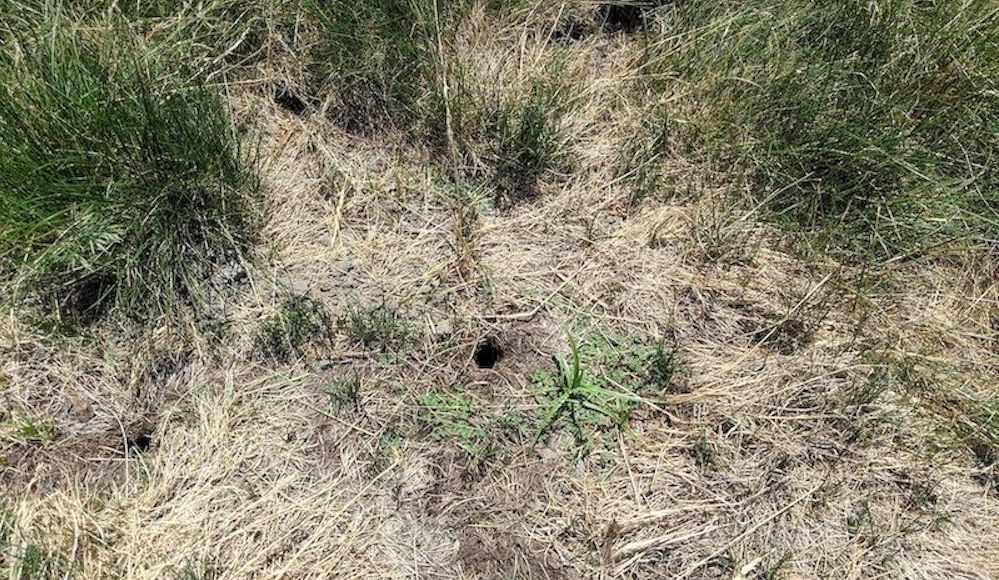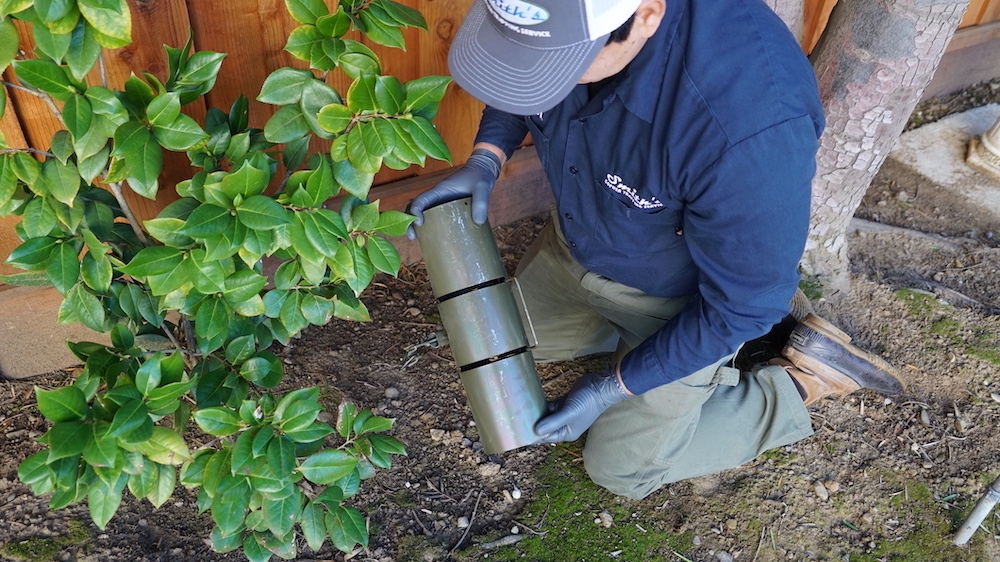Have you noticed runways, holes, or gnaw marks in your outdoor space? Are your plants suddenly dying?
If so, you likely have a vole problem.
To keep these pests from destroying your property, you’ve got to act fast.
Here at Smith’s Pest Management, we help California property owners trap voles every day, and we’ve created this comprehensive guide to help you do the same.
Key Takeaways
- To trap a vole, identify active runways, choose the right trap, bait and position the trap, check it frequently, dispose of dead rodents properly, and consider hiring a professional if you’re not seeing results.
- While moles and voles are commonly confused, moles don’t eat plants. Voles, on the other hand, consume all sorts of vegetation and can destroy your garden.
- If you need help creating an effective trapping program, contact Smith’s Pest Management for assistance: (408) 871-6988.
Before You Get Started
1. Make sure you’re dealing with a vole
Your first step is to confirm that the pest that’s messing up your property is indeed a vole.
Voles are small, stocky rodents with short tails, small ears, and eyes that are barely visible through their fur.
Compared to mice, voles have a more compact, rounded appearance.
Unlike moles, which are insectivores with elongated bodies and large, paddle-like forefeet designed for digging, voles are rodents with compact, rounded bodies.
They eat plants and can often be seen darting rapidly across your lawn or landscaping.
2. Check for damage
Next, look for signs of vole damage, which typically includes gnawed stems and roots, tiny tooth marks on tree bark, and girdling at the base of woody plants and shrubs.
Voles like to stay under cover, so you should also look for small, round holes in the soil surface, often near the base of trees or shrubs.
These are entryways to their burrows. If you find well-worn runways in the grass or mulch that connect these burrow entrances, it’s a sure sign that voles are active in your space.
3. Gather your equipment
Before you get busy trapping voles, gather the tools and equipment you’ll need.
We recommend wearing sturdy gloves to prevent leaving human scent on the traps and grabbing a few different traps designed for small rodents, such as snap traps or live traps.
It’s also useful to have small marker flags to identify trap locations and a spade or shovel to set your traps into the burrows.
4. Choose the right trap

Here’s a quick overview of the different kinds of traps available:
- Snap Traps: These are highly effective for catching voles. They are designed to snap shut quickly when triggered by the vole, ensuring a swift and humane kill.
- T-Rex Traps: A popular choice due to their effectiveness and ease of use. T-Rex traps are powerful, quick-kill snap traps designed to catch voles and other small rodents. They are durable and – unlike wooden snap traps – can be reused multiple times, which makes them a cost-effective option for controlling vole populations.
- Live Traps: For those who prefer not to kill the voles, live traps can be a good option. These traps capture the vole alive so you can release it somewhere far from your property. Keep in mind that if you’re going to use live traps, you’ve got to be prepared to check and empty them often. Additionally, you should always check your local wildlife regulations to make sure catching and releasing voles is legal in your area.
- Glue Traps: These traps use a sticky surface to catch and hold voles. While some homeowners like to use them, they’re typically considered less humane than other options since they don’t kill rodents quickly, and they can cause significant distress in trapped animals. To prevent accidental catches of kids, pets, and non-target species, glue traps should always be placed inside trap boxes.
While there are several trap options out there, we recommend using mouse-sized snap traps to control voles.
Since voles are roughly the same weight and size as mice, these traps will provide a quick, humane kill.
5 Steps To Trap a Vole

1. Find Active Runways
Identifying active vole runways and holes is super important for effective trapping.
Here are some key points to help you find the active runways and holes, which will allow you to place your traps correctly:
- Know the Signs: Look for shallow runways on the surface of your lawn or landscaping. These runways are usually about one to two inches wide and are commonly found in grass, mulch, or flower beds. Vole holes are small, round openings about one to two inches in diameter. These entrances are usually located near the base of trees, shrubs, or in open grassy areas.
- Look for Fresh Activity: Active runways and holes will show signs of recent use, such as fresh droppings, clipped vegetation, or newly disturbed soil around the entrances.
- Inspect for Vegetation Damage: Check your plants for gnaw marks, especially around the base. Voles feed on roots, stems, and bark, but they often don’t travel far from their runways to forage.
2. Bait and Position the Trap
This is a two-step process. First, you need to position the trap, and then you need to bait it.
Positioning vole traps effectively is super important to ensuring effective vole control – when you place the traps in high-activity areas, you maximize your chances of catching these little critters.
With that in mind, here are a few tips for proper trap placement:
- Use mouse traps for best results – stick a nail through the trap, which will allow you to anchor it in the dirt.
- Position a bunch of mouse traps perpendicular to active vole runways, with the trigger side facing the runway. Make sure you have traps facing both left and right. Set a lot of traps (10 or 20 even) to increase your chances of success.
- Place traps near vole burrow entrances and near plant beds and gardens where voles have been feeding.
- Position traps under natural cover like brush piles or within mulch to offer a sense of security to the voles, encouraging them to approach the traps.
- If you want to cover the traps, use gutter material or PVC pipe (Even cardboard will work) to create a half-tunnel over the trap. This keeps pets and other critters from interfering with the traps and makes voles more likely to step on your traps.
Once you’ve chosen the right spot for your traps, you’ll need to bait them.
Since voles are herbivores, they’ll be attracted to foods like apple slices, peanut butter, pieces of carrot, or cereal grains.
To bait your traps, use a small amount of food – roughly the size of a pea or a small bean. This attracts the voles without overwhelming the trap. Using too much bait can lead to the vole taking the bait without triggering the trap.
3. Check the Traps Frequently
Check vole traps frequently, ideally every 24 hours.
Regular inspections allow you to remove captured voles quickly and reset and re-bait your traps if needed.
It’s also the best way to identify traps that aren’t set in the right area and move them so they can be more effective.
If your trap has been set for a day or two and you haven’t caught a vole, that’s a good sign that you need to move it to a different area.
4. Dispose of Dead Rodents Carefully
You trapped a vole!
Awesome news.
Now, follow these tips to get rid of it safely:
- Wear gloves to avoid direct contact with the dead vole.
- Carefully remove the vole from the trap.
- Place the vole in a plastic bag and seal it tightly (if you’re using disposable traps, place the used trap in the bag, as well). Put the sealed bag inside another plastic bag and tie the second bag tightly.
- Dispose of the double-bagged vole in an outdoor trash can.
- Wash your hands thoroughly in hot, soapy water.
5. Monitor your Results
Keep track of the number of voles you catch each day, as well as the trap locations and the food baits you’re using.
If some traps are always empty, move them to areas with more vole activity, like new runways or burrow entrances.
Try different baits to see which works best. Regularly monitor and adjust your approach to manage your vole infestation as efficiently as possible.
When Should You Hire a Professional?

If you’re not seeing results from your DIY trapping efforts after a few days, consider hiring a pest management professional like Smith’s Pest Management.
Pros like our team have the experience and tools to manage vole populations effectively, especially when they’re large or persistent.
In addition to trapping the voles that are currently destroying your property, we’ll also help you learn how to prevent future infestations and prevent ongoing damage to your space.
Mistakes to Avoid
Don’t waste your time or energy on these common mistakes:
- Using the Wrong Trap Type: Not all traps work for voles. For example, some live traps are meant for larger critters (like rats) and may not trigger properly when voles enter them. With this in mind, always make sure that you’re using traps designed for small rodents like voles.
- Incorrect Trap Placement: If you place your traps in low-activity areas, they just won’t catch anything. For best results, always place traps on active runways and in or near burrow entrances.
- Inconsistent Monitoring: Check and adjust your traps daily to maximize their effectiveness.
- Poor Sanitation Practices: Dispose of voles quickly to make sure your traps can keep working. Always handle dead voles carefully and clean your traps and equipment to minimize the risk of disease transmission.
- Giving Up Too Soon: Trapping voles takes time. Stay consistent, and don’t give up too quickly.
Tips to Prevent Voles
- Eliminate Food Sources: Clean up fallen fruits, vegetables, and seeds that attract voles in your lawn or garden.
- Remove Shelter Opportunities: Clear away piles of brush, leaves, and other debris that can provide shelter for voles. Regularly mow your lawn to keep the grass short and reduce available shelter for voles.
- Install Physical Barriers: Use hardware cloth or wire mesh with small openings to protect garden beds and trees. Bury the mesh several inches underground to make it impossible for voles to burrow beneath it. You can also surround your garden beds with a border of coarse gravel to deter voles from digging into your space.
- Encourage Natural Predators: Owls, hawks, and snakes are natural predators of voles. Create habitats that attract these animals by installing nesting boxes for birds of prey.
- Check for Signs Regularly: Frequently inspect your property for signs of vole activity. Early detection allows for prompt action before a small problem becomes a bigger infestation.
Are Voles Taking Over Your Bay Area Property? Smith’s Pest Management can Help!
Don’t settle for living with vole damage.
Give our team a call for comprehensive, professional, reliable vole extermination services that will get rid of those pesky voles once and for all.
Contact us at (408) 871-6988 to learn more about our services or request an inspection today!
FAQs
Why do I suddenly have voles in my yard?
A sudden increase in voles could be due to a variety of things.
Voles are attracted to environments where they can easily find food, shelter, and moisture.
If your yard has lots of fallen fruit, seeds, or other edible plant materials, it can quickly become a vole magnet.
Additionally, thick vegetation, piles of leaves, brush, or yard debris provide ideal shelter and nesting sites for voles, which draw them to your space.
Changes in weather patterns, nearby construction, or other disruptions to their natural habitats can also drive voles to seek safe havens in your lawn or garden.
Is it bad to have voles in your yard?
Yes, having voles in your yard can be an issue for a few reasons.
Voles can cause massive damage to lawns, gardens, and landscaping by feeding on the roots and bark.
Left unchecked, voles can even kill trees with their gnawing and tunneling behavior.
Their burrowing activities can create unsightly runways and holes in your yard, leading to soil erosion and potentially destabilizing plant roots.
As if that weren’t bad enough, voles are some of the most rapidly reproducing rodents of all time.
If you’ve got one vole on your property, you’ve got dozens, and your infestation can quickly spiral out of control.
This means it’s important to respond to even the occasional vole sighting aggressively and use lots of traps to get rid of these destructive little critters.
Will a mouse trap kill a vole?
Yes, a mouse trap will kill a vole.
Mice and voles are about the same size and weight, so mouse traps are definitely effective at catching and eliminating voles.
How do I tell if I have voles or moles?
While mole and vole may sound the same, these are very different animals.
Here’s what you need to know:
- Size and Appearance: Voles are small rodents, typically measuring 4 to 6 inches in length, with a stocky build, a short tail, and small eyes and ears. Moles, on the other hand, are larger, ranging from 4.4 to 7 inches long. They have distinctive, broad front feet with sharp claws designed for digging. Moles also have elongated snouts and tiny, nearly hidden eyes and ears.
- Diet: Voles are herbivores, which means they feed on plants, roots, bulbs, and bark. They can cause significant damage to gardens and landscaped areas as they gnaw on roots and stems (check out this video for examples). In contrast, moles are insectivores, which means they don’t eat plants. While they may mess up your plants by digging through their root systems, moles only eat earthworms, grubs, and other soil-dwelling insects. For an example of what mole damage looks like, check out this video.
- Habits: Voles create shallow burrow systems and are known for making numerous surface runways, which can appear as extensive networks of trails across your yard. These runways, often about 1-2 inches wide, are easily visible when the grass is pushed down. Moles, however, build deeper tunnels and their presence is often indicated by molehills—small mounds of dirt pushed to the surface as they dig. Moles also create raised ridged tunnels just beneath the surface, which can feel spongy when walked upon.
For more information on the difference between moles and voles, check out our blog.


